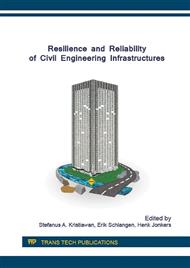p.188
p.193
p.202
p.208
p.214
p.220
p.226
p.233
p.240
Performance of Ferro Foam Concrete Girder Beam Subjected to Static Load
Abstract:
Ferro foam concrete is an alternative material which consist of a combination between wire mesh and foam concrete. The advantage of this material is in addition to its ability to carry the load, this type of material is lightweight, and easy to be produced. The objectives of this study are to study performance of ferro foam concrete girder beam subjected to static load, and to investigate the beam to be used as an alternative material for bridge girder. Six ferro foam concrete channel profile that is configured into three I profile with 300 mm, 450 mm, and 600 mm with four layer wire mesh were tested in Structural Laboratory of Syiah Kuala University. This profile has a span of 2000 mm, and 150 mm, 175 mm, and 300 mm wingspan. Foam concrete used in this research consist of cement, water, foam agent, and 10 % pozzolan. Material properties for concrete 32.47 MPa compression strength, and 421 MPa for yield strength of reinforcement with D8, and 421 MPa for wire mesh G 12.7. The specimens were tested using four point loading. Three units of LVDT placed at a distance of 250 mm and 1000 mm from the support. Based on test results, it was found that the maximum load that can be carried by the channel profile configuration I with 300 mm height is 17.45 tf on deflection of 23.32 mm, for a profile with a height of 450 mm is 20.72 tf on deflection of 14.85 mm, and for a profile with a height of 600 mm was 22.48 tf on deflection of 37.74 mm.
Info:
Periodical:
Pages:
214-219
Citation:
Online since:
July 2016
Authors:
Keywords:
Price:
Сopyright:
© 2016 Trans Tech Publications Ltd. All Rights Reserved
Share:
Citation:


